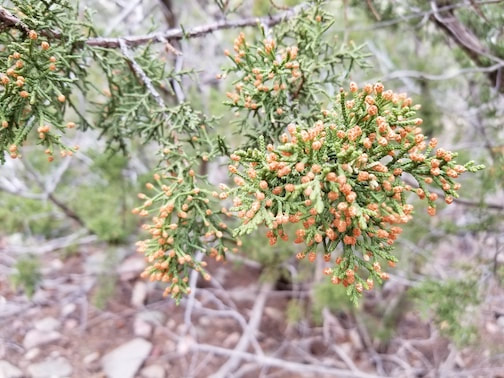Santa Fe residents are sadly familiar with the unwelcome sight in the photograph above: a luxurious bouquet of male cones on a One-seed juniper bearing millions of grains of irritating pollen. While the juniper the diminutive tree that holds our landscape together, it definitely has a shadow side. And March is the month it reveals it.
This very day, I read in my almanac, “I have said that much of life and perhaps the best of it is not quite “nice”. The business of early spring is not; it transpires in nakedness and candor, under high empty skies. . . .The cedar sows the wind with its pollen now, because it is a relict of an age before bees, and it blooms in a month essentially barren of winged pollinators.”
Ultimately this panspermian haze will result in crops of waxy, purplish-blue juniper berries (actually a female seed-cone with fleshy scales) important to many birds and animals here on the western slopes of the Rockies. But what a curse the begetting is, in March!
The quote is from “An Almanac For Moderns” by Donald Culross Peattie.
This very day, I read in my almanac, “I have said that much of life and perhaps the best of it is not quite “nice”. The business of early spring is not; it transpires in nakedness and candor, under high empty skies. . . .The cedar sows the wind with its pollen now, because it is a relict of an age before bees, and it blooms in a month essentially barren of winged pollinators.”
Ultimately this panspermian haze will result in crops of waxy, purplish-blue juniper berries (actually a female seed-cone with fleshy scales) important to many birds and animals here on the western slopes of the Rockies. But what a curse the begetting is, in March!
The quote is from “An Almanac For Moderns” by Donald Culross Peattie.


 RSS Feed
RSS Feed
